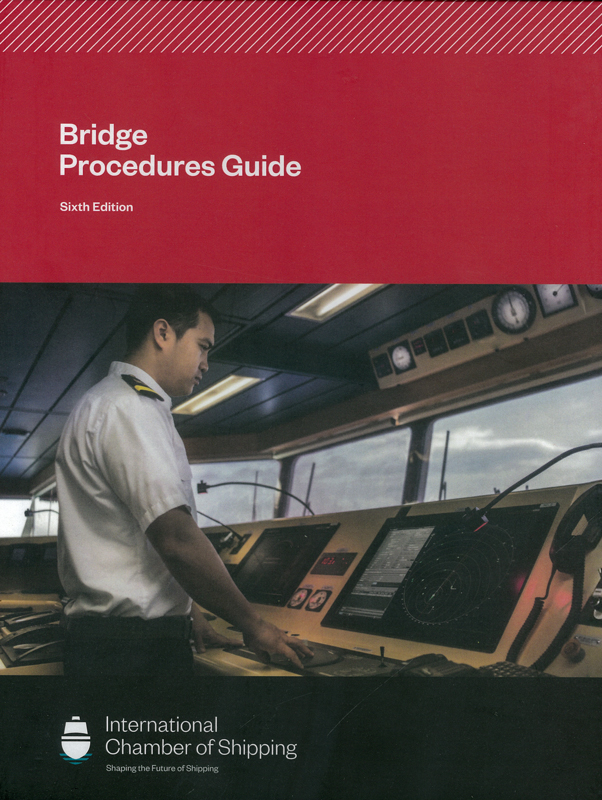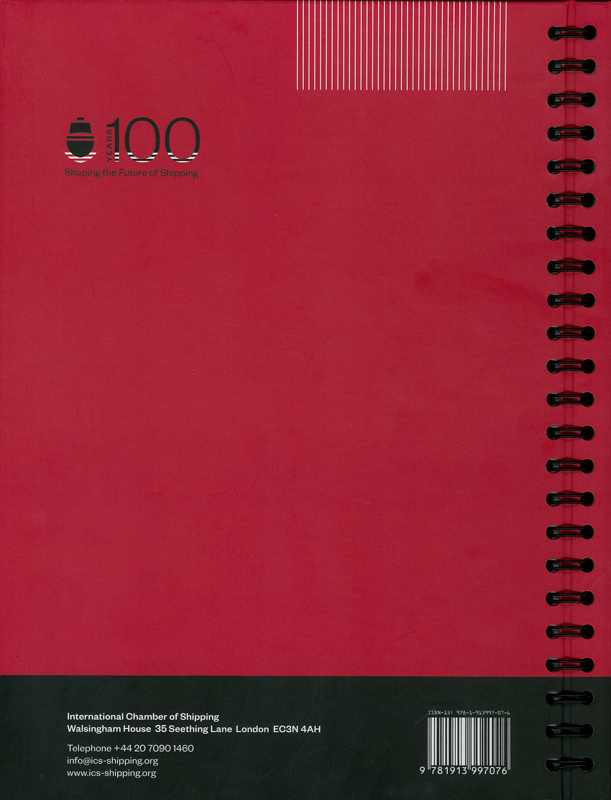Сб с 10 до 16
Bridge Procedure Guide/Руководство по процедурам на мостике (6-е издание)
Мы не можем гарантировать его наличие и поступление на наш склад по указанной цене
Издание на английском языке
This fully updated sixth edition continues to embrace internationally agreed standards and recommendations adopted by the International Maritime Organization (IMO). The Guide also includes extensive checklists for use by companies, Masters and those officers responsible for developing ship specific checklists for bridge procedures.
This sixth edition includes:
- Increased guidance on non-navigational procedures;
- New sections on the human element, Electronic Chart Display and Information System (ECDIS) safety settings, category zone of confidence (CATZOC), weather routeing, communications with the engine control room, cargo operations, risk assessments and permits to work, ship stability, ballast water management, errors associated with Global Navigation Satellite System (GNSS), and characteristics of radar;
- New checklist for rescue in enclosed spaces;
- More visual aids to improve understanding and support on board training; and
- Simplified language to reflect current best practice in writing guidelines and checklists.
Content
Abbreviations
Definitions
Chapter 1. Introduction
1.1. Safe navigation
1.2. An effective bridge team
1.3. Passage planning
1.4. Technology
1.5. Pilotage
Chapter 2. Effective bridge organisation
2.1. Overview
2.2. Bridge resource management (BRM) and the bridge team
2.2.1. Composition of the bridge team
2.2.2. Sole look-out
2.2.3. The bridge team
2.2.4. The bridge team and the Master
2.2.5. Bridge team leadership, resource management and teamwork
2.2.6. Bridge team human element
2.2.7. Briefing and debriefing
2.2.8. The bridge team and internal communication
2.2.9. Bridge team duties
2.2.10. New personnel and familiarisation
2.2.11. Hours of rest
2.2.12. Record keeping and schedules
2.2.13. Drug and alcohol policies
2.2.14. Use of English
2.3. Company policy and procedures
2.3.1. Information distribution
2.3.2. Orders
2.4. Mobile phones and personal electronic devices
2.5. Bridge internet and email
2.6. Emergency preparedness
Chapter 3. Passage planning
3.1. Principles
3.2. Responsibility for passage planning
3.2.1. Company involvement
3.2.2. Passage planning constraints
3.3. Appraisal
3.3.1. Official charts
3.3.2. Official nautical publications and other information
3.4. Planning
3.4.1. Passage planning in ocean waters
3.4.2. Passage planning in coastal waters
3.4.3. Passage planning in pilotage waters
3.4.4. Passage planning using ECDIS
3.4.5. Category zone of confidence (CATZOC)
3.4.6. Finalising the passage plan
3.4.7. Weather routeing
3.4.8. Passage plan briefing
3.4.9. Amendments to routes
3.4.10. Transferring positions
3.4.11. Maritime safety information (MSI)
3.4.12. Planning an anchorage
3.4.13. Ships’ routeing
3.4.14. Ship reporting systems
3.4.15. Vessel traffic services (VTS)
3.5. Executing and monitoring the passage plan
Chapter 4. Duties of the Officer of the Watch
4.1. Overview
4.2. Effective watch handover
4.3. Managing the bridge watch
4.4. Maintaining a proper look-out
4.4.1. Control of night vision
4.4.2. Sole look-out
4.5. Bridge navigational watch alarm system (BNWAS)
4.6. Calling the Master
4.7. Familiarity with bridge layout and equipment
4.8. Situational awareness
4.9. Communication with the engine control room
4.9.1. Situation reviews
4.9.2. Unattended machinery space (UMS) operation
4.9.3. Manoeuvring
4.10. Monitoring shipboard operations
4.11. Cargo operations
4.12. Risk assessments and permits to work
4.12.1. Risk assessments
4.12.2. Risk assessment matrix
4.12.3. Permits to work
4.12.4. Permit to work systems
4.13. Ship stability
4.14. Navigation and control
4.14.1. Manoeuvring information
4.14.2. Use of propulsion
4.14.3. Safe speed
4.14.5. Track control systems
4.15 Monitoring the passage
4.15.1. Navigation in coastal or restricted waters
4.15.2. Monitoring techniques
4.15.3. Monitoring a passage plan on ECDIS
4.15.4. Amending the passage plan
4.16. Compliance with the COLREGS
4.16.1. Lights, shapes and sound signals
4.16.2. Risk of collision
4.16.3. Action to avoid collision
4.17. Navigation under pilotage
4.18. Maintaining an anchor watch
4.19. GMDSS watchkeeping
4.19.1. Radio watchkeeping
4.19.2. Emergency communications
4.19.3. Maritime safety information
4.19.4. Routine and general communications
4.19.5. GMDSS log keeping
4.19.6. Communications equipment tests
4.19.7. False distress alerts
4.20. Long range identification and tracking (LRIT)
4.21. Environmental compliance
4.21.1. Pollution by oil or harmful substances
4.21.2. Reporting obligations
4.21.3. Reporting points
4.21.4. Other sources of pollution
4.21.5. Energy efficiency
4.21.6. Ballast water management
4.22. Periodic checks of navigational equipment
4.22.1. Operational checks
4.22.2. Routine tests and checks
4.22.3. Software anomalies
4.23. Recording bridge activities
4.24. Emergency situations
4.24.1. Management
4.24.2. Search and rescue
4.25. Danger reporting
4.26. Helicopter operations
4.27. Security awareness
Chapter 5. Operation and maintenance of bridge equipment
5.1. General
5.1.1. Carriage requirements
5.1.2. Equipment performance
5.1.3. Software anomalies
5.1.4. ECDIS anomalies
5.1.5. Cyber security
5.2. Steering gear and automatic pilot
5.2.1. Operation and testing
5.2.2. Steering control
5.2.3. Autopilot - Heading control
5.2.4. Autopilot - Automatic track-keeping
5.2.5. Off-course alarm
5.2.6. Berthing systems
5.3. Compass systems
5.3.1. Magnetic compass
5.3.2. Gyro compass
5.3.3. GNSS compass
5.3.4. Compass errors
5.3.5. Rate of turn (ROT)
5.4. Speed and distance log
5.4.1. Speed measurement
5.4.2. Types of speed log
5.4.3. Recording of distance travelled
5.5. Echo sounders
5.6. Bridge navigational watch alarm system (BNWAS)
5.7. Navigation lights and signalling equipment
5.8. Voyage data recorder (VDR)
5.8.1. Overview
5.8.2. VDR requirements
5.8.3. Preserving records
5.8.4. VDR testing
5.8.5. VDR playback
5.9. Electronic position fixing systems
5.9.1. Global Navigation Satellite System (GNSS)
5.9.2. Differential GNSS
5.9.3. GNSS associated errors and alarms
5.9.4. GNSS receivers
5.9.5. Geodetic datum
5.9.6. Chart accuracy and precision
5.10. Automatic identification system (AIS)
5.10.1. AIS overview
5.10.2. AIS aids to navigation (AtoN)
5.10.3. Satellite AIS (SAT-AIS)
5.10.4. AIS and SAR
5.11. Radar and radar plotting aids
5.11.1. Characteristics of radar
5.11.2. Safe use of radar
5.11.3. Detection of targets
5.11.4. Radar image overlay (RIO)
5.11.5. Radar and collision avoidance
5.11.6. Radar plotting aids
5.11.7. Heading and speed inputs
5.11.8. Automatic radar target acquisition
5.11.9. AIS targets on ARPA
5.11.10. Radar and navigation
5.11.11. Search and rescue transponder (SART)
5.12. Charts and nautical publications
5.12.1. Carriage of charts and nautical publications
5.12.2. Official charts and nautical publications
5.12.3. Electronic charts
5.13. Electronic Chart Display and Information System (ECDIS)
5.13.1. Overview
5.13.2. Chart updates
5.13.3. ECDIS software updates
5.13.4. Back-up requirements
5.14. Integrated bridge systems (IBS) and integrated navigation systems (INS)
5.15. GMDSS communications
5.15.1. GMDSS equipment
Chapter 6. Pilotage
6.1. Overview
6.2. Preparation for pilotage
6.2.1. The passage plan
6.2.2. The ship and bridge team
6.2.3. The pilot
6.2.4. The pilot card
6.3. Safe pilot boarding
6.3.1. Pilot boarding time
6.3.2. Embarking the pilot
6.4. Master/pilot information exchange (MPX)
6.4.1. Extra pilots
6.5. Duties and responsibilities
6.5.1. Bridge team responsibilities
6.5.2. Pilot’s responsibilities
6.6. Manoeuvring
6.6.1. Mooring operations
6.6.2. Use of tugs and mooring boats
6.7. Preparing the outbound passage plan
6.8. Pilotage exemption certificates (PECs)
6.9. Deep sea pilots
Appendices
Appendix A. Dynamic positioning (DP)
Appendix В. ECDIS carriage requirements
Appendix С. Checklists
Appendix D. Posters
Appendix E. Recommended industry publications



